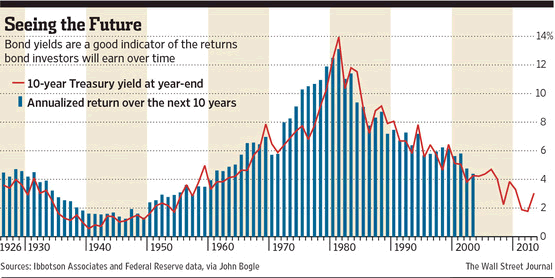Jack Bogle is best known as the founder of Vanguard index funds, but he also dispenses great common sense advice about investing. I’ve written previously about his long-term stock return methodology including this prediction for stock returns for 2010-2020.
He also has a simple method to predicting future long-term bond returns, which is by simply taking the current bond yield. For example, the current yield of 10-year Treasuries is 2.7%, so roughly 3% is likely the future 10-year return.
This is explained further in this recent WSJ article (via Abnormal Returns). This chart shows it best:

Since 1926, he notes, the entry yield on the 10-year Treasury explains 92% of the annualized return an investor would have earned over the subsequent decade had he or she held the bond to maturity and reinvested the coupon payments at prevailing rates.
Similarly, the entry yield on the Barclays U.S. Aggregate Bond index (of investment-grade U.S. bonds) explains 90% of its 10-year returns for the years 1976 to 2012, says Tony Crescenzi, a portfolio manager and strategist at Pacific Investment Management Co.
The Vanguard Total Bond Market ETF (BND) which tracks the Barclays U.S. Aggregate Bond index currently has an SEC yield of 2.2%, which doesn’t seem like a very exciting number to look forward to. While this shows that our expectations should be very modest, it’s still important to remember that we hold bonds as a counterbalance to stock price volatility. As long as we hold them together, the overall picture is much more tolerable.
 The Best Credit Card Bonus Offers – 2025
The Best Credit Card Bonus Offers – 2025 Big List of Free Stocks from Brokerage Apps
Big List of Free Stocks from Brokerage Apps Best Interest Rates on Cash - 2025
Best Interest Rates on Cash - 2025 Free Credit Scores x 3 + Free Credit Monitoring
Free Credit Scores x 3 + Free Credit Monitoring Best No Fee 0% APR Balance Transfer Offers
Best No Fee 0% APR Balance Transfer Offers Little-Known Cellular Data Plans That Can Save Big Money
Little-Known Cellular Data Plans That Can Save Big Money How To Haggle Your Cable or Direct TV Bill
How To Haggle Your Cable or Direct TV Bill Big List of Free Consumer Data Reports (Credit, Rent, Work)
Big List of Free Consumer Data Reports (Credit, Rent, Work)
How accurate was his prediction for 2000-2010?
Excellent analysis.
(my wife and I are seating down TODAY with an adviser to talk about long term safe (=bond) investment!)
[one comment, Jonathan:
Printing your articles is a little bit hidden (under the Share option) and cumbersome (it acts as Print Screen, i.e. the right hand column is printed as well).
I see many blogs that have a Print option that formats just the body of the article especially for print.
I hope you can add such feature soon]
I’ll see if there is a simple WordPress plugin that can make printing easier.
Jonathan,
I clicked the link “long term stock return methodology” and read your article from May 24, 2007. After almost 7 years how are the predictions holding up?
Well, the 10-year trailing return of the S&P 500 index is 7.16% annualized as of 2/28/14. The 5-year window drops 2008 so it is considerably higher at 23%.